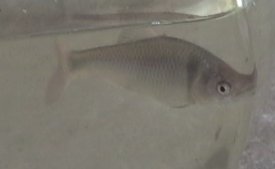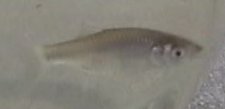 |
 |
|
|
Last Updated: 2/21/14


I only got my red shiners in the fall of 1999 and do not know much first hand about them. All of the following information comes from books and internet sources. If you have any information on the red shiner, please send it to me. In the cases where I state "unknown," it means that I do not know but others may know. Please let me know about any information on red shiners.
Quick Information
Description
Setup and Water Preferences
Sexing
Breeding
My Red Shiners
Links and Pictures
For information on my red shiners' setup, visit my 153 gallon pond page.

Common name: Red shiner, rainbow dace, horse-head minnow, red horse
minnow or shiner, rosysided dace, Asian fire barb, African fire barb, redfin giant danio,
blue dace, shiner (note that the red shiner is not a dace, minnow, barb, or danio!)
Scientific/Latin names: Cyprinella lutrensis, formerly
Notropis lutrensis
Maximum length: 2 to 4 inches (usually 3)
Colors: Greenish brown, red and blue on breeding males
Temperature preference: 33 to 77 degrees F, 60 to 77 degrees F preferred
pH preference: 7 to 7.5
Hardness preference: Medium to hard
Salinity preference: Unknown, probably low to 1 tsp per gallon
Compatibility: Good
Life span: 3 to 4 years
Ease of keeping: Easy
Ease of breeding: Easy

The red shiner, Cyprinella lutrensis, is also called the rainbow dace, horse-head minnow, or redhorse minnow. They grow about 2 to 4 inches long with males longer (3 inches on average). The breeding males are a silvery blue with dark red stomachs and sometimes a green stripe across their bodies. The males also get breeding tubercles (like goldfish, koi, rosy red minnows, fathead minnows, and many other fish). Females and non-breeding males are greenish brown.
Red shiners school with their own and similar species near the surface and mid-water. They eat algae and insect larvae with a preference for bugs. Red shiners are often sold as bait fish.
Unfortunately, when red shiners are released into waters where they are not native, they can deplete the populations of fish native to those waters. They may directly eat the eggs and larvae of endangered or rare fish or compete with them for space and food. Red shiners also hybridize with similar species. After mosquito fish, they may be the largest threat to native fishes of the southwestern USA according to the USGS.

Red shiners tend to live in rivers with moderate current. They are very tolerant of extremes in water quality such as pH 5 to 10. Red shiners can survive in turbid and moderately polluted waters. They do not like fast moving water.

The breeding males are a silvery blue with dark red stomachs and sometimes a green stripe across their bodies. Their fins turn red, and they have a blue triangular patch behind their heads. The males also get breeding tubercles on their mouth and head. Breeding males may have a black tip on their dorsal fins. Breeding females are fatter and less colorful. With their bright blues and reds, males are often sold in pet stores. In most cases, no females are present so I wonder how many would-be breeders could not figure out how to breed more of these beauties.

Breeding occurs spring to early fall. Red shiners usually breed over sunfish nests and vegetation even though the sunfish will eat them. Males guard the sunfish nest area. They may fan away the gravel in a spot. Eggs may also be put in the crevices of rock piles, logs, etc. The parents release eggs and sperm over the area where they fall to the ground and stick. Females can lay up to 400 to 600 eggs. In a tank, red shiners may spawn in a dish of gravel. While they sort of stash eggs, they do not give them any care after laying them and will eat them. Eggs hatch in 3 to 5 days or so depending on temperature. It may take up to a week before they are free- swimming. Sexually maturity is obtained after a few years and most adults only spawn a few times in their lives. Red shiners will hybridize with similar Cyprinella species which can adversely affect the other species survival.
Charles had the following to share that he sent on 7/15/07. I edited the spelling and grammar
some.
"I have recently taken up the hobby of collecting native fishes. One of my favorites has been the
red shiner. They are very abundant in this area as I live in central Nebraska, and they are the most
common fish in the Platte river. I have read your red shiner page and was wondering if you have
tried to breed these guys again. My experience in this is somewhat mixed, while I have no trouble
at all getting them to spawn (they go at it all summer long), keeping them alive has been a little
more tricky. If I leave the fry in the aquarium, they are eaten right away. A couple of years ago, I
tried putting the fry in a small aquarium. They all died in about three weeks, I'm not sure why but
I'm guessing that because of their small size they can't eat traditional fry foods like brine shrimp.
This year, I tried a different approach. I remove the eggs from the aquarium when I clean the
gravel. I can't see them but, if I find a place where the gravel is all stuck together, I gently scoop
itout. If I cannot find such a clump, I just save the water, and there are usually a few dozen fry in
about a week; if I find a clump, then there are hundreds. All I do to keep them alive is almost
nothing, I have just left them in the bucket that I use to clean the aquarium with and leave them
in the sun to promote algae growth. They have been alive since May. I have given them frozen
daphnia that I mashed between my fingers but I'm not sure if they ate it or not. Now that they are
getting a little bigger, they are eating both brine shrimp and daphnia. They are still in buckets
because they are still too small to avoid being eaten. What I find amazing is the variety of
behavior they exhibit. In the fall, just after they have stopped spawning, they do what I am calling
schooling. They group themselves together on one end of the aquarium in some kind of pecking
order and wiggle there fins very fast as if they were swimming for all they are worth but they go
nowhere; how they pull this off, I don't know. In the winter, they turn a drab silver grey and
become very boring, But in the spring, it seems they change colors over night, and the fireworks
begin. This is what puzzles. I have read everything that I can find about red shiners and nothing
has described this behavior. When the males are competing for spawning, they push each other
while swimming circling around each other, at the same time they make a very audible
'knocking' noise, I can hear it from at least eight feet away! Nothing I have read has ever
mentioned this. Have you heard of this? I hope you find some of this at least interesting if not
useful...."

On 10/27/99, 16 red shiners were added to my 153 gallon pond. There were a mix of males and females (I did not try to count them since they were too fast.). One male was almost dead (listed to the side) and mostly likely died shortly after being put into the pond. Another male was removed dead on 7/27/00. He showed no signs of injury or parasites.
On cleaning out the filthy (full of earthworms) pond on 3/26/00, I netted about half a dozen red shiners. Some could have evaded the net since I only changed 50% of the water. One of the males that I caught was in full red and blue color. He was gorgeous.
When the pond was cleaned in early September of 2000, only four fish were caught, and none appeared to be red shiners. Six more small red shiners were added to the pond on 9/28/00. Hopefully, they will do better. One was removed dead the next day so they were not off to a good start.
The pond was completely emptied and cleaned on 3/26/01. About 4 male and 5 or more female shiners were found still alive. In June, 2001, half a dozen or so babies were seen in the pond. I thought they were baby red shiners. On 8/4/01, I found a dead, 3 inch, male red shiner. He may have gotten into a fight with another male. On 8/31/01, I removed a dead, 2 inch, female red shiner. There was no obvious reason for her death. On 9/17/01, there was another dead female red shiner. She had two holes bitten from her. The shiners must be dying from old age (they are three-years-old) or something of which I am not aware.
I cleaned out the pond on 4/2/02. There were only seven live fish left. Three were adult Southern redbelly dace. Four were the babies I had seen in June, 2001. They have long fins and appear to be baby Southern redbelly dace and not baby red shiners (although it is still possible). I also found two dead fish, one may have been a female red shiner. I definitely do not have any adult red shiners left. I am pretty sure the babies are not red shiners either. I really liked the shiners and had hoped they would do better. I never would have guessed the dace would do better.
Well, when I cleaned out the 153 gallon pond on 4/2/03, there were three fish. One was a Southern redbelly dace but the other two were red shiners, I am pretty sure! They were not dace, bluntnose minnows, or Ozark minnows so that only left shiners which means the babies from last year were most likely shiners then! I believe (but am not 100% sure) that the two fish I found were a male and female red shiner. Their photos are at the top of this page.
On 3/29/04, when I cleaned out the 153 gallon pond, the two red shiners were still alive! The male looked good but the female was anorexic. Here are their photos below!
A pair of red shiners on 3/29/04:
Male red shiner - left side.
Male red shiner - left side.
Male red shiner - right side.
Female red shiner - left side.
Female red shiner - left side.
When I cleaned the 153 gallon pond on 3/25/05, those two red shiners were not to be found. I no longer have any red shiners at all. They have all died of old age. It is too bad I cannot just buy some!

Red shiner - photo of a non-breeding male (I think)
Red shiner - some information
Red shiner - photo and information (this site may no longer work)
Red shiner - photo of non-breeding male (I think) and some information
Red shiner - drawing and some information
Red shiner - information
Minnows - article includes a short section on red shiners
North American Native Fishes Association
Native Fish Conservancy - I am a member since 10/99
North American Freshwater Fishes
|
|
Pet Link Banner Exchange: |

|
|
|
There have been 51,181,002 file views (file views since 2006, page views before that) to Fishpondinfo from December 1, 2003 through August 17, 2019 (stats lost after that). |
|

|

|
E-mail RobynCopyright © 1997-2025 Robyn Rhudy |

|
 |